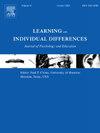儿童创造力发展的轨迹
IF 3.8
1区 心理学
Q1 PSYCHOLOGY, EDUCATIONAL
引用次数: 0
摘要
孩子们的创造力是如何变化的?虽然这是创造力发展研究的核心问题,但跟踪儿童创造能力各方面变化的纵向调查很少。本研究纵向考察了学龄前儿童(N = 194)和学龄早期儿童(N = 236)综合创造能力的发展轨迹。我们还分析了这种发展是否与发散性思维的变化有关。孩子们完成了四次(学龄前儿童)或六次(小学生)的创造性思维-绘画生产测试(TCT-DP),这是一种综合创造能力的衡量标准,每隔六个月进行一次,托兰斯创造性思维测试(TTCT)(三次)。潜在增长曲线模型显示了综合创新能力的增长趋势,但参与者之间的变化速度和模式也存在很大的差异。潜在混合模型揭示了综合创新能力的三种变化轨迹:(1)低起点-中等增长轨迹,即综合创新能力起点低,但随时间的推移而增加;(2)中-开始-密集-成长轨迹,其综合创造能力显著提高;(3)稳定-高轨迹,其综合创造能力在第一波中得分较高,之后保持稳定。这些轨迹在他们最初的发散思维和流畅性、灵活性和独创性的变化模式上趋于不同。我们根据创造力发展的潜在特质以及在创造力文献中整合以人为中心和动态方法的可能性来讨论这些差异。教育相关性声明本研究对儿童中期创造能力的发展轨迹提供了重要的见解。它揭示了儿童的创造力,尤其是他们的综合创造能力,随着年龄的增长而增加。教育工作者和课程开发者可以从理解这些轨迹中受益,因为它们强调了从小培养创造力和根据个体差异调整教学方法的重要性。综合创造能力和发散性思维之间的差异也表明,在以创造力为重点的教育项目中,需要量身定制的方法。本文章由计算机程序翻译,如有差异,请以英文原文为准。
The trajectories of creativity development in childhood
How does children's creativity change? Although this is a central question to the developmental studies of creativity, longitudinal investigations that follow the changes in various aspects of children's creative abilities are scarce. This study longitudinally examines the trajectories of the development of synthetic creative abilities in preschool (N = 194) and early school-age (N = 236) children. We also analyzed if this development was associated with changes in divergent thinking. Children solved the Test for Creative Thinking-Drawing Production (TCT-DP), a measure of synthetic creative abilities, either four (preschool children) or six times (primary school students), with sessions six months apart and the Torrance Tests of Creative Thinking (TTCT) (three times). Latent growth curve models demonstrated the increasing trend in synthetic creative abilities, yet there was also substantial variability in the rate and pattern of changes among participants. Latent mixture models revealed three trajectories of changes in synthetic creative abilities: (1) low-beginning-moderate-growth trajectory, whose synthetic creative abilities started low yet increased in time; (2) medium-start-intensive-growth trajectory, whose synthetic creative abilities increased substantially, and (3) stable-high trajectory, who scored high in synthetic creative abilities in the first wave and kept stable afterward. These trajectories tended to differ in their initial divergent thinking and the patterns of changes in fluency, flexibility, and originality. We discuss these differences in light of potential idiosyncrasies in creativity development and the possibility of integrating person-centered and dynamic approaches in the creativity literature.
Educational relevance statement
This research provides vital insights into the developmental trajectories of children's creative abilities in middle childhood. It reveals that children's creativity, especially their synthetic creative abilities, tends to increase as they grow older. Educators and curriculum developers can benefit from understanding these trajectories, as they highlight the significance of fostering creativity from a young age and adapting teaching methods according to individual variability. The differences between synthetic creative abilities and divergent thinking also suggest a need for tailored approaches in creativity-focused educational programs.
求助全文
通过发布文献求助,成功后即可免费获取论文全文。
去求助
来源期刊

Learning and Individual Differences
PSYCHOLOGY, EDUCATIONAL-
CiteScore
6.60
自引率
2.80%
发文量
86
期刊介绍:
Learning and Individual Differences is a research journal devoted to publishing articles of individual differences as they relate to learning within an educational context. The Journal focuses on original empirical studies of high theoretical and methodological rigor that that make a substantial scientific contribution. Learning and Individual Differences publishes original research. Manuscripts should be no longer than 7500 words of primary text (not including tables, figures, references).
 求助内容:
求助内容: 应助结果提醒方式:
应助结果提醒方式:


